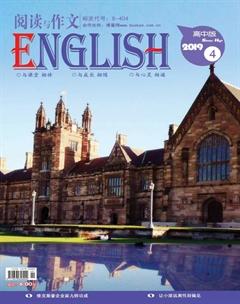完形填空
先通讀短文,掌握其大意,然后从A、B、C、D四个选项中选出一个可以填入相应空白处的最佳答案,并将其标号填入题前括号内。
(一)
Have you ever had problems in your life and dont know how to be happy? If ___1___, you will find “Being a Happy Teenager” by Australian writer Andrew Matthews ___2___. In his book, Matthews ___3___ us how to have a happy life and answers the ___4___ of teenagers. There are many ___5___ such as parents and friends, and the book ___6___ we should stop being angry and forgive. The book tells us of useful skills ___7___ how to put what you have learned into pictures of your mind to ___8___ your memory better.
Many teenagers think ___9___ happiness comes from a good exam result ___10___ praise from other people. But you can ___11___ be happy when there are no such “good” things. Success comes from a ___12___ attitude. ___13___ you learn from problems, you will have success in the future.
Some school students have ___14___ such as being too tall or too short. ___15___ Matthews tells us that ___16___ comes from thinking about things in a positive ___17___. If you are ___18___, people notice you and you can get a better view at the movie; if you are short, your clothes and shoes ___19___ less room in your bedroom! This is Matthews most important ___20___: you choose to be happy!
( )1. A. so B. not C. it D. do
( )2. A. true B. real C. useful D. bad
( )3. A. orders B. tells C. asks D. shows
( )4. A. problems B. questions C. ideas D. quizzes
( )5. A. lessons B. classes C. courses D. subjects
( )6. A. says B. writes C. tells D. thinks
( )7. A. for example B. such as C. so as D. so that
( )8. A. make B. turn C. let D. change
( )9. A. what B. how C. that D. whether
( )10.A. and B. but C. so D. or
( )11.A. yet B. already C. still D. forever
( )12.A. bad B. good C. honest D. true
( )13.A. If B. As C. After D. Because
( )14.A. questions B. difficulty C. trouble D. problems
( )15.A. But B. And C. So D. Or
( )16.A. success B. happiness C. failure D. trouble
( )17.A. way B. means C. road D. street
( )18.A. short B. small C. tall D. fat
( )19.A. take B. spend C. cover D. make
( )20.A. work B. lesson C. teaching D. study
(二)
Michel is a young girl who works for the police as a handwriting expert. She has helped ___1___ many criminals ___2___using her special talents.
When she was fourteen, Michel was already so interested in the ___3___ in her friends handwriting ___4___she would spend hours ___5___ them. After ___6___ college she went to France for a special two-year class in___7___ at the School of Police Science.
Michel says that it is ___8___for people to hide their handwriting. She can discover ___9___ of what she needs to know simply by looking at the writing with her own ___10___, but she also has machines ___11___help her ___12___ different kinds of paper and ink. This knowledge is often ___13___ great help to the___14___. Michel believes that handwriting is a good sign of 15 kind of person the writer ___16___. “I wouldnt go out with a fellow ___17___ I didnt like his handwriting.” She says. But she adds she___18___ in love with her future husband, a young policeman ___19___ she studied his handwriting. It is later proved to be all right, ___20___.
( )1. A. search B. follow C. catch D. judge
( )2. A. with B. as C. like D. by
( )3. A. differences B. same C. way D. method
( )4. A. that B. as C. as to D. so that
( )5. A. writing B. settling C. uncovering D. studying
( )6. A. finishing B. attending C. starting D. finished
( )7. A. books B. handwriting C. tongues D. letter
( )8. A. possible B. safe C. easy D. impossible
( )9. A. most B. all C. nothing D. little
( )10. A. hands B. mind C. head D. eyes
( )11. A. they B. those C. that D. with which
( )12. A. carry out B. give out C. look out D. make out
( )13. A. of B. to C. with D. for
( )14. A. teachers B. people C. police D. students
( )15. A. what B. all C. which D. to which
( )16. A. is B. becomes C. belongs D. changes
( )17. A. whether B. if C. after D. unless
( )18. A. felt B. dropped C. caught D. fell
( )19. A. after B. when C. because D. before
( )20. A. however B. but C. too D. either
參考答案与解析
(一)
1. A。if so 意为“如果这样”。
2. C。从后文我们知道,澳大利亚这位作家写的这本书对于觉得并不幸福的孩子是很“有用的”。
3. B。这本书能够“告诉”读者如果幸福地生活。
4. B。这里主要考查 question 和 problem 这两个词语之间的差异。Question通常指口头提出的问题。
5. D。subject 在这里指的是“主题”。
6. A。say 常用来表示书报、信件、留言等上面所陈述的内容。
7. B。such as 常用来举例,放在所举例子的前面。而for example 则只能用作插入语,在句中通常用逗号与句子分开。
8. A。make 的后面可接形容词作宾补。
9. C。that 在本句中引导一个宾语从句。
10. D。or 表示选择。
11. C。still 意为“还、依然”。
12. B。在作者看来,成功来自良好的生活态度。
13. A。If 在这里表示假设的条件,意为“如果”。
14. D。problems 在这里指的是“问题、难题”。
15. A。从前后的逻辑看,这里应用一个表示转折的连词。
16. B。综合全文的逻辑看,作者认为,幸福来自于积极的思维方式,即看事情要看它好的一面。这样,人就会活得很快乐了。
17. A
18. C。只有高个子的人才会在看电影的时候有较多的视线。
19. A。take less room 意为“占较少的空间”。
20. B。lesson 在这里指的是“教训”。
(二)
“字如其人”。为警方工作的书法专家Michel相信通过笔迹能看出写字的人是什么类型,但她爱上她的丈夫却是在研究他的笔迹之前。
1. C。search意为“搜寻”;follow意为“跟随”;catch意为“捕获”;judge意为“审理”。根据上下文答案应该选C。
2. D。by表示方式或手段。
3. A。对朋友书法上的差异感兴趣。
4. A。so…that…结构,意为“如此…以致于”。
5. D。花费时间研究书法上的差异。
6. A。after+现在分词,作时间状语。其逻辑主语与主句的主语一致
7. B。根据语境可知是专门学了两年书法。
8. D。Michel说人们的笔迹是不可能掩饰的。
9. A。根据下文借助机器,可知是能发现大部分需要知道的东西。
10. D。看书法当然用眼睛。
11. C。that引导定语从句并在从句中作主语。
12. D。carry out 意为“完成, 执行”;give out意为“分发”;look out意为“留神”;make out意为“辨认出”。根据句意“她也用机器帮她辨认纸. 墨。”选D。
13. A。of great help = helpful.
14. C。根据文章第一句可知。这种学问通常对警察有很大帮助。
15. A。which指一定范围内的“哪一个”;what指具体内容,what kind of 指“什么类型的”。
16. A。系动词表状态。
17. B。if引导条件状语从句,“如果我不喜欢他的书法。”
18. D。fall in love with 意为“爱上”。
19. D。作者一向认为可以以字取人,但她爱上她未来的丈夫却在研究他的笔迹之前。
20. A。表示转折关系。however可位于句中也可位于句末。
- 阅读与作文(英语高中版)的其它文章
- 当你老了
- 爱有归途
- 维克斯豪企业家九转功成
- Pay a Visit to Wuhan
- 投石忌器
- 爱屋及乌

